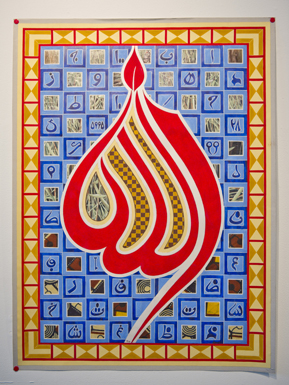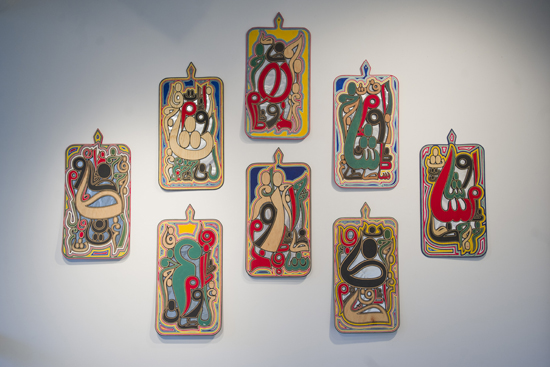Spiritually Charged Art That Heals
Yelimane Fall’s calligraphy on display at Sherman Gallery
Walk into the Sherman Gallery and the first thing you’re likely to notice is that the walls seem to pulsate with color. In the gallery’s current show, Yelimane Fall: African Calligraphy in Action, the Senegalese calligrapher’s acrylic paintings explode with vibrant reds, blues, greens, yellows, even hot pink. Step closer to the paintings and you’ll see that they convey a deeply spiritual message as well.
Fall, who signs his work MF (Messenger of Faith) draws inspiration from the philosophy of Shaykh Ahmadu Bamba, a Senagalese saint who founded the Muridiyya Sufi Brotherhood in the 19th century. Bamba preached a message of nonviolence, hard work, and forgiveness, and Fall sees his paintings as a way of spreading the beliefs of the pacifist, scholar, and poet.
Cynthia Becker, a College of Arts & Sciences associate professor of African art, and one of the show’s curators, says Fall’s paintings are filled with intense symbolic meaning. Each of his works, she notes, “contains many levels of meaning that are often hidden into the image itself, encouraging contemplation.”
Fall initially trained in mechanical drawing and design, but switched to calligraphy after becoming a disciple of Bamba. That helps explain the bold, graphic quality of his paintings, which are based on the Sufi conviction that there are secrets to be learned as one approaches the divine.

In Faith, painted last year, the word “Allah” appears in bright red, a color that represents faith. The blue in the background symbolizes the immensity of the sky, while white connotes purity. Taken together, the three colors are meant to evoke God. In the background, 28 letters of Arabic script have been arranged to form a pattern that resembles a khatem, or mystical seal, often used in Islamic healing. The work is a direct reference to numerology, a branch of Islamic mysticism. Each letter is related to a number and has a mystical meaning that protects and heals.
That mysticism is also evident in Fall’s 2005 series of eight paintings resembling Qur’anic writing boards. The titles of the works come from the largest Arabic letter in the center of the composition. And each letter, Fall says, is endowed with life and certain healing properties. “Hot” letters, represented by the color red, heal human illnesses associated with cold (e.g., rheumatism) and “cold” letters, symbolized by the color green, heal “hot” illnesses, such as fever. The letters can be combined to express a different spiritual idea.

“Fall’s art continues the mission of Shaykh Ahmadu Bamba by spreading blessings to all people,” says Becker. “He uses his paintings to illustrate inspirational lectures.”
Nowhere is that more evident than in a series of acrylics inspired by Bamba’s writings for children, in which he used animal forms to teach life lessons. The paintings—of a donkey, a cat, a lion, a pig, a dog, and a vulture—reflect Bamba’s belief that people can learn lessons of patience by watching donkeys and vultures, gentleness by watching cats, restraint and moderation from lions, and so forth.
Fallou Ngom, a CAS associate professor of anthropology and director of the African Language Program, says the artist’s work “blends beauty, ethics, and the value of human life. His art is not limited only to intellectual appreciations, but interacts with human hearts.”

The Sherman Gallery show is cosponsored by the College of Fine Arts School of Visual Arts and the West African Research Association. Fall’s residency goes to the end of November, so visitors to the gallery may find themselves face-to-face with the artist, who is there most days creating a mural with some students from CFA and CAS. But, says Becker, “anyone is welcome to come and help Yelimane paint his mural.” During his residency, Fall will also be meeting with students in several CFA and CAS classes before returning to his home in Dakar, Senegal.
Yelimane Fall: African Calligraphy in Action is on view at the Sherman Gallery, George Sherman Union, 775 Commonwealth Ave., second floor, through December 16. The gallery is open Tuesday to Friday, 11 a.m. to 5 p.m., and Saturday and Sunday, 1 to 5 p.m. The show is free and open to the public.

Comments & Discussion
Boston University moderates comments to facilitate an informed, substantive, civil conversation. Abusive, profane, self-promotional, misleading, incoherent or off-topic comments will be rejected. Moderators are staffed during regular business hours (EST) and can only accept comments written in English. Statistics or facts must include a citation or a link to the citation.